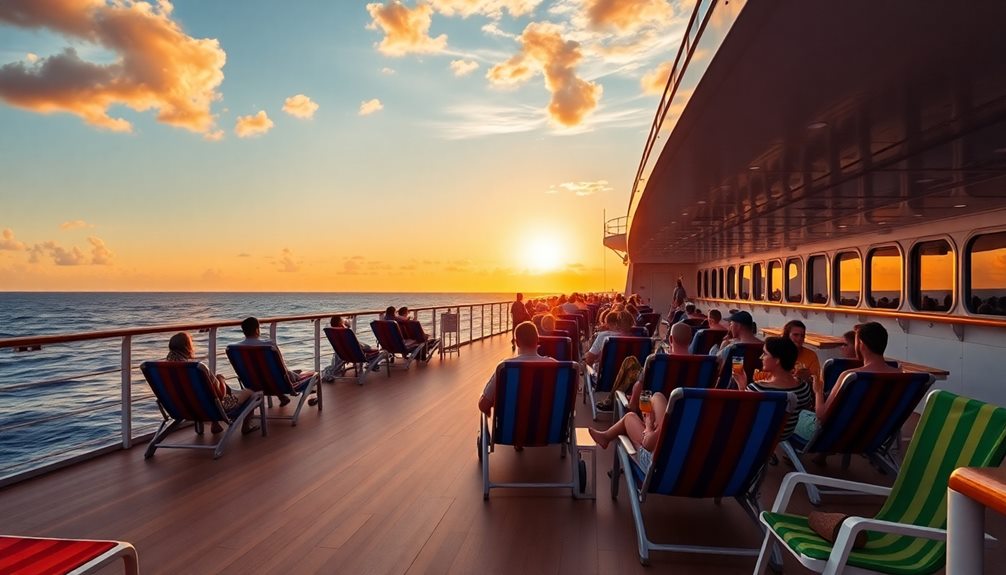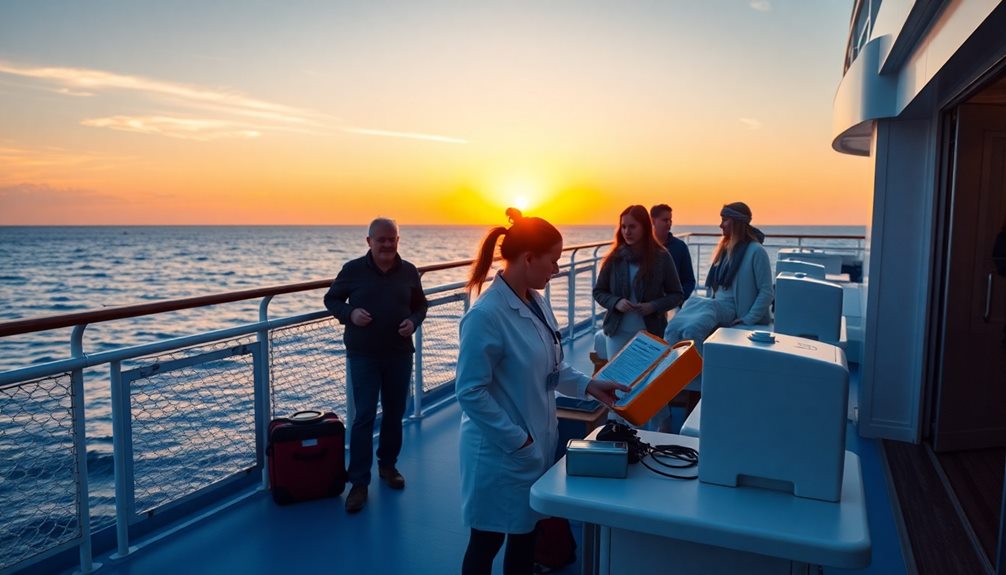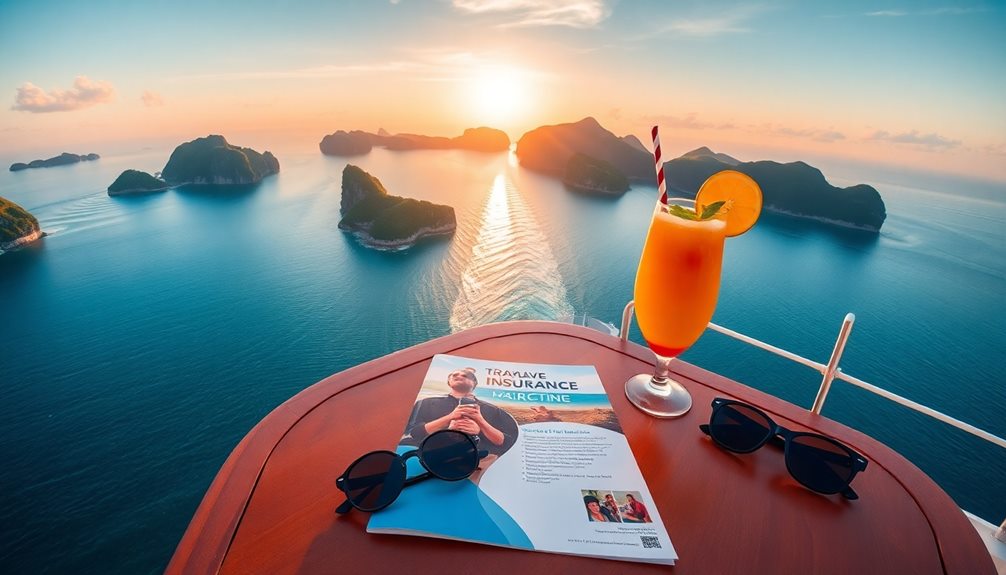Seasickness can spoil your cruise, but you can minimize its effects with some smart strategies. Choose a mid-ship cabin on a lower deck to reduce motion. Eat light snacks, like ginger crackers, to settle your stomach. When you feel uneasy, go outside for fresh air and focus on the horizon. Over-the-counter medications like Dramamine can help if taken before boarding. Ginger and acupressure wristbands are great natural options too. Staying hydrated is essential, so sip water or ginger ale. With these tips in mind, you'll be better prepared for your journey. Discover some more effective methods to enhance your experience.
Key Takeaways
- Choose mid-ship cabins on lower decks to reduce motion and minimize the risk of seasickness.
- Consume small, light meals and stay hydrated, avoiding heavy foods and alcohol.
- Use over-the-counter medications like Dramamine or ginger remedies to prevent nausea.
- Engage in light outdoor activities and get fresh air to distract from discomfort.
- Start medications before boarding and familiarize yourself with the ship layout for easy access to fresh air.
Understanding Seasickness
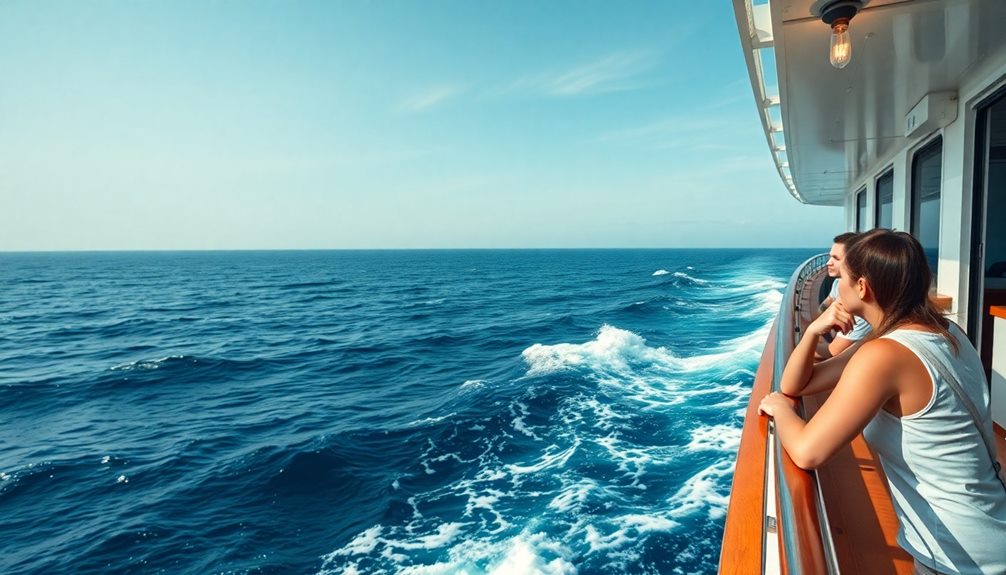
Seasickness can feel like a rollercoaster gone wrong, leaving you dizzy and nauseous as the ship sways. This condition, a form of motion sickness, arises when your inner ear senses movement that's not aligned with what your eyes see. Your brain gets conflicting signals, and that's when the symptoms kick in. You might experience nausea, dizziness, cold sweats, or even vomiting.
Some people are more susceptible to seasickness than others, with personal sensitivity and anxiety playing significant roles. Curiously, children under two tend to be immune, while women and older adults often face more challenges.
If you've struggled with these symptoms in the past, you know how uncomfortable they can be, and the duration can vary greatly. Many start feeling better within hours, while others might take a couple of days to adjust to the ship's motion.
To manage seasickness effectively, it's important to identify your personal triggers, like inadequate rest or poor ventilation. By understanding how seasickness works and recognizing your symptoms, you can take proactive steps to enjoy your cruise without the rollercoaster ride of discomfort.
Causes and Symptoms

Seasickness occurs when your brain receives conflicting signals from your inner ear and what you see around you.
You might experience common symptoms like nausea, dizziness, and cold sweats, which can vary greatly from person to person.
Factors like personal sensitivity, anxiety, and even lack of sleep can make you more prone to these unpleasant effects.
Sensory Mismatch Effects
When you find yourself on a cruise, your body may struggle to keep up with the movements of the ship, leading to a sensory mismatch. This phenomenon occurs when your inner ear detects motion that your eyes don't perceive. Fundamentally, your brain receives conflicting signals: your inner ear senses the ship's movement, while your visual input remains relatively still. This confusion can trigger seasickness.
Individual sensitivity plays a significant role in how you experience this sensory mismatch. Some people may feel dizzy or nauseous even with slight movements, while others remain unaffected. Factors like anxiety or lack of rest can heighten your sensitivity, making you more prone to seasickness.
Interestingly, seasickness tends to affect children and women more than elderly individuals, who are generally less susceptible. Children under two years old are usually immune to this condition.
Recognizing your personal triggers is vital; by identifying them, you can take preemptive measures to mitigate the onset of seasickness. Understanding this sensory mismatch can help you prepare and enjoy your cruise experience more fully.
Common Symptoms Identified
Experiencing motion sickness on a cruise often involves a range of unsettling symptoms that can quickly dampen your enjoyment. These symptoms arise due to conflicting signals your brain receives from your eyes and inner ear. Commonly reported symptoms include nausea and dizziness, along with cold sweats and fatigue.
Here's a quick overview of the most common symptoms:
| Symptom | Description | Severity Level |
|---|---|---|
| Nausea | A feeling of queasiness in the stomach | Mild to Severe |
| Dizziness | A sensation of spinning or lightheadedness | Moderate to Severe |
| Cold Sweats | Sudden perspiration from discomfort | Mild to Moderate |
You may find yourself more susceptible to these symptoms, especially if you're in rough waters. Symptoms typically manifest within the first few hours of motion and can last from a few hours to a couple of days. Recognizing these symptoms early can help you take preemptive measures to alleviate your discomfort before it escalates. Understanding what symptoms to watch out for is key to managing your cruise experience effectively.
Personal Sensitivity Factors
Your personal sensitivity to seasickness can considerably affect how you experience a cruise. Some individuals, particularly children and women, have a heightened susceptibility to seasickness, while the elderly often show less sensitivity. The symptoms can range from dizziness and nausea to cold sweats and vomiting, especially in rough waters or if you have a history of motion sickness.
Seasickness arises from a mismatch between the signals your eyes receive and what your inner ear senses. This conflict can confuse your brain, leading to unpleasant symptoms. Several factors can intensify your personal sensitivity, including inadequate rest, anxiety, poor ventilation, and what you eat before and during the cruise.
To manage seasickness effectively, it's vital to identify your personal triggers. These might include specific types of motion or environmental conditions that you find uncomfortable. By recognizing these triggers early on, you can take proactive measures to minimize symptoms and enhance your cruise experience.
Preventive Measures

Choosing the right cabin can make a world of difference in preventing seasickness on a cruise. Opt for mid-ship cabins on lower decks, as they experience less motion, greatly reducing your chances of feeling queasy.
When planning your itinerary, select routes that traverse calmer waters and steer clear of rough seas, especially during hurricane season from June to November.
To further combat seasickness, keep yourself hydrated. Drink small amounts of water or ginger ale throughout the cruise, as dehydration can worsen symptoms.
It's also wise to consume light meals, avoiding heavy, spicy, or greasy foods that can trigger nausea. Eating frequent, light meals helps your stomach stay settled.
Don't forget to be proactive about seasickness medications. Consult your physician for suitable options, and consider starting any recommended medications or patches before you board for maximum effectiveness.
Cabin Selection Tips
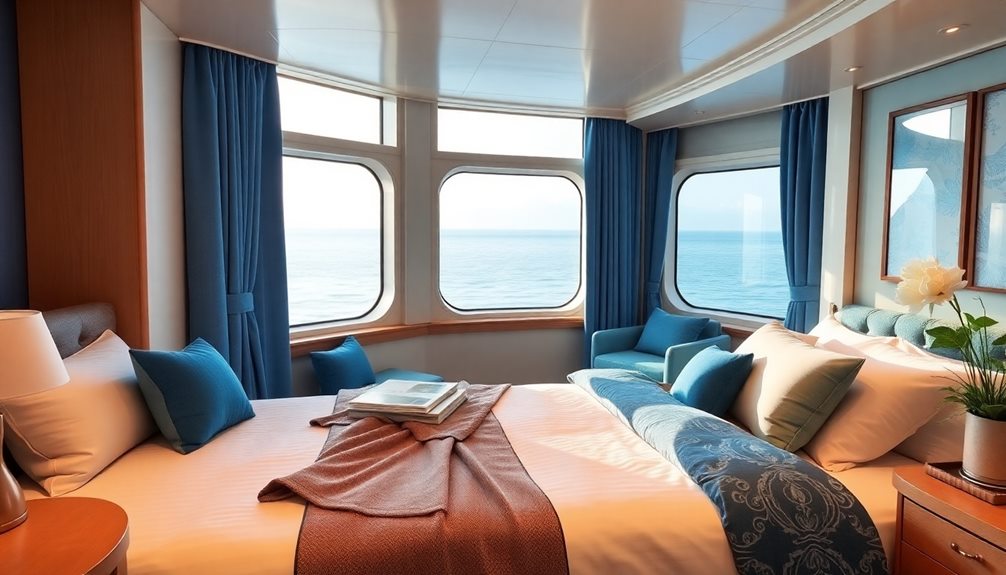
When you're booking your cabin, aim for a mid-ship location to minimize motion and create a more stable environment.
Lower deck staterooms are also a smart choice, as they sit closer to the waterline and usually feel less movement.
Mid-Ship Location Benefits
Selecting a mid-ship cabin can greatly enhance your cruise experience, especially if you're prone to seasickness. This location is ideal since it experiences the least amount of swaying and rolling compared to the front or back of the ship. By choosing a mid-ship cabin, you can considerably minimize seasickness, allowing you to enjoy your trip more fully.
Many modern cruise ships, like those from Celebrity Cruises, come equipped with advanced stabilizers that further enhance the stability of mid-ship cabins. These stabilizers help reduce the motion you might feel, which can greatly improve your overall comfort while at sea.
Additionally, a mid-ship location offers easier access to on-board amenities and common areas. This means you won't have to trek through the ship to reach restaurants, pools, or entertainment, allowing you to balance relaxation with enjoyment without the distraction of seasickness symptoms.
Lower Deck Advantages
Staying on the lower decks of a cruise ship can considerably reduce your chances of feeling seasick. The lower decks typically experience less sway, which means you'll likely feel more stable during your journey. Opting for a stateroom located mid-ship is particularly beneficial, as these areas are closer to the ship's center of gravity. This positioning helps minimize motion and enhances your overall stability.
When selecting your stateroom, keep these tips in mind:
| Cabin Location | Advantages | Disadvantages |
|---|---|---|
| Lower Deck, Mid-Ship | Best stability, less motion | Less scenic views |
| Lower Deck, Front | Closer to upper decks | More pronounced movement |
| Lower Deck, Back | Proximity to amenities | Increased sway |
| Upper Deck, Mid-Ship | Great views, central location | More motion, higher seasickness risk |
| Upper Deck, Front/Back | Stunning vistas | Significant motion |
Lastly, consider selecting a stateroom with a window. Having access to horizon views can help reset your equilibrium and lessen feelings of nausea, making your cruise more enjoyable.
Dietary Recommendations
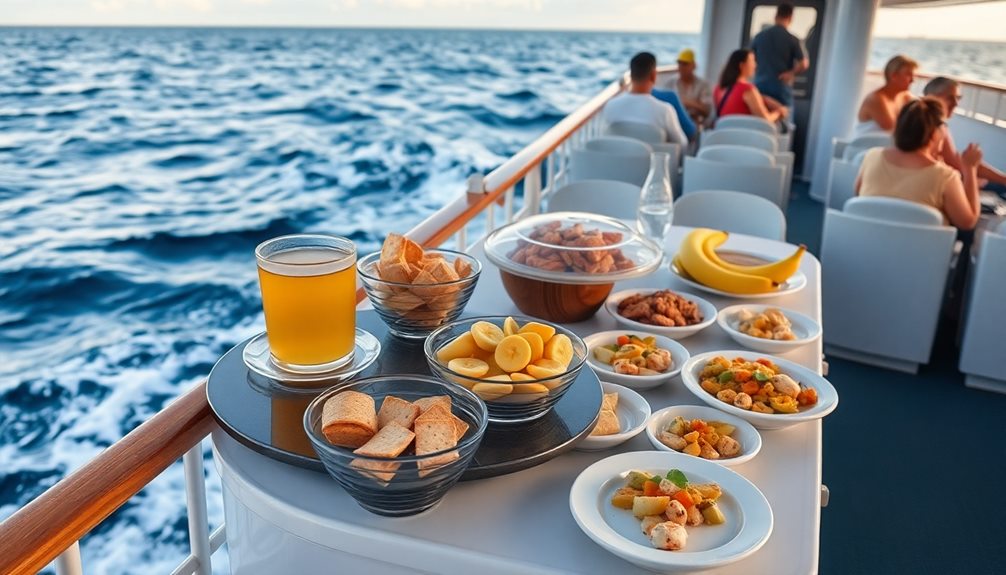
To effectively manage seasickness on a cruise, it's essential to focus on your dietary choices. Start by consuming small meals throughout the day. This approach helps maintain stable blood sugar levels and can prevent nausea. Foods like crackers paired with ginger ale can be particularly effective; ginger has natural anti-emetic properties that may alleviate symptoms during the first 24 hours of sailing.
Make sure to stay hydrated. Drinking water or non-caffeinated beverages is important to prevent dehydration, which can worsen seasickness symptoms.
In addition, you'll want to avoid heavy meals, especially those that are fatty or spicy, as they can exacerbate feelings of nausea and discomfort.
Limiting your alcohol intake is also significant. Alcohol can dehydrate you and further disturb your balance, increasing the likelihood of seasickness. It's best to cut back on alcohol in the days leading up to your cruise and during the trip itself.
Onboard Strategies
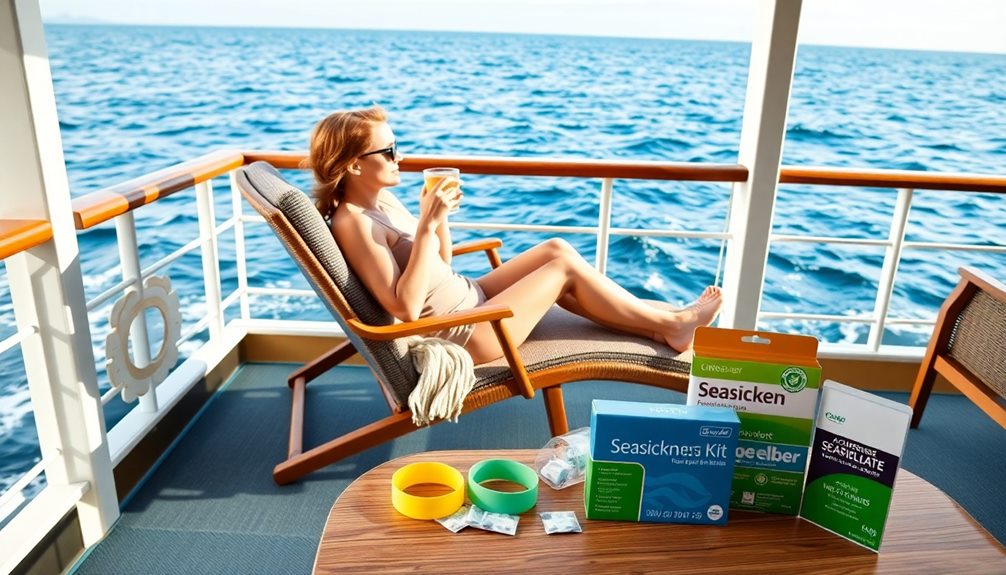
To combat seasickness while onboard, consider sitting in mid-ship areas where the movement is less pronounced.
Getting fresh air can work wonders, so don't hesitate to step outside when you feel uneasy.
Pair that with light snacks to keep your stomach settled, and you'll have a better chance of enjoying your cruise.
Mid-Ship Seating Benefits
Choosing mid-ship seating on a cruise can be a game-changer for those prone to seasickness. This area of the ship experiences less rolling, making it ideal for a smoother sailing experience. By opting for mid-ship locations, you'll enjoy a more stable ride, which greatly enhances passenger comfort. Plus, many cruise ships feature mid-ship lounges and dining options, allowing you to access amenities without the discomfort of excessive motion.
Here's a quick overview of the benefits of mid-ship seating:
| Benefit | Description |
|---|---|
| Reduced Motion | Less rolling compared to the front or back of the ship |
| Smoother Sailing | Diminished likelihood of seasickness symptoms |
| Stable Ride | Closer to the ship's center of gravity |
| Convenient Amenities | Easy access to lounges and dining options |
| Engaging Activities | Distractions available to help with potential nausea |
Fresh Air Access
Fresh air access is essential for those dealing with seasickness on a cruise. Getting outside to breathe in the fresh air can help reset your body's equilibrium, alleviating nausea and discomfort.
Whenever you start feeling queasy, head to the deck. Focusing on the horizon stabilizes your visual input, reducing disorientation from the ship's motion.
If you're in your stateroom, consider opening the windows or opting for a cabin with a balcony. This not only enhances your access to fresh air but also allows you to enjoy the sights as you sail.
Whenever possible, engage in light outdoor activities on deck. Whether it's a stroll or simply lounging, staying active can distract you from nausea symptoms while promoting fresh air exposure.
Additionally, take advantage of ship amenities like outdoor lounges. These spaces offer comfort and the chance to enjoy the fresh air without feeling isolated.
Light Snack Recommendations
When it comes to managing seasickness on a cruise, opting for light snacks can make a considerable difference. Consuming bland options like crackers and toast can help settle your stomach and prevent nausea, as they're easy to digest.
Instead of heavy meals, focus on small meals throughout the day. This approach helps maintain stable blood sugar levels, reducing the risk of nausea.
Incorporating ginger-based snacks into your diet can also be beneficial. Ginger ale or ginger candies are popular choices that provide natural relief from nausea.
When snacking, it's crucial to stay hydrated, so drink plenty of water or electrolyte beverages. Dehydration can worsen nausea, making hydration a key component of your strategy.
Be mindful of what you're eating—avoid acidic and spicy foods, as they can exacerbate nausea symptoms and discomfort.
Sticking to light snacks and small meals, along with proper hydration, can notably improve your cruise experience. Remember, your goal is to keep your stomach settled and enjoy the journey ahead!
Motion Sickness Medications
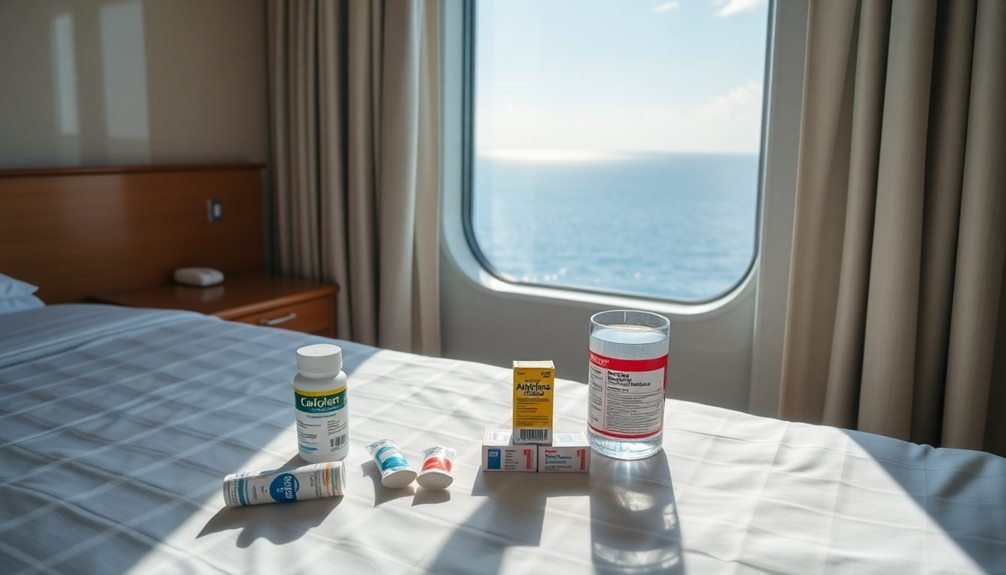
To combat seasickness effectively, many travelers turn to motion sickness medications that can provide much-needed relief during a cruise. One popular option is the Transderm Scop patch, which can offer effective relief for up to three days. However, it requires a prescription and may cause side effects like dry mouth and drowsiness.
If you prefer over-the-counter options, consider Dramamine or Meclizine (Bonine). These are commonly used to prevent and treat seasickness, but be cautious—they can induce drowsiness, especially when mixed with alcohol.
If your symptoms persist, prescription medications like promethazine are available through ship physicians and can be administered in various forms, including suppositories. To maximize the effectiveness of any motion sickness medications, it's best to start taking them before you board the ship, particularly if you're prone to seasickness.
Before you begin any medication, it's essential to consult with a healthcare professional. They can guarantee the medication is safe for you and address potential interactions with other medications or existing health conditions.
This way, you can enjoy your cruise without worrying about the effects of motion sickness.
Natural Remedies

If you're looking for natural ways to tackle seasickness on your cruise, several remedies can help ease your discomfort. One of the most popular options is ginger. You can consume it as tea, candy, or supplements, and many find it effective in reducing nausea.
Another useful tool is the Sea-Band wristband, which employs acupressure to alleviate symptoms and is easily found over-the-counter.
Eating green apples is another simple remedy. Their natural properties can soothe nausea, so keep a few handy during your trip. Staying hydrated with clear fluids is essential too, as it helps maintain balance and prevents dehydration.
You might also want to explore aromatherapy with calming scents like peppermint and lavender. These scents can provide relief and ease nausea symptoms.
Additionally, snacking on light foods like crackers, especially when paired with ginger, can further help settle your stomach.
Small Ship Benefits

Small ship cruises offer a distinct advantage over larger vessels, making them an appealing choice for many travelers. With fewer passengers on board, you'll enjoy personalized service that enhances your overall experience. The crew can focus on your needs, ensuring a memorable journey.
These vessels can access shallower waters and less crowded ports, allowing for unique itineraries that include hidden gems and off-the-beaten-path destinations. You'll have the chance to explore places larger ships simply can't reach.
Moreover, small ship cruises prioritize environmental sustainability, making them an excellent choice for eco-conscious travelers. They often implement eco-friendly practices that reduce your ecological footprint.
Cultural immersion is another hallmark of small ship cruises. You'll engage more deeply with local communities and customs during shore excursions, enriching your travel experience.
Here's a quick comparison of small ship cruise benefits:
| Benefits | Advantages | Examples |
|---|---|---|
| Personalized Service | Greater attention from crew | Customized dining |
| Unique Itineraries | Access to hidden gems | Lesser-known ports |
| Cultural Immersion | Engagement with local communities | Authentic experiences |
| Environmental Sustainability | Eco-friendly practices | Reduced waste |
| Breathtaking Scenery | Stunning views and wildlife | Galapagos, Alaska |
Tips for First-Time Cruisers
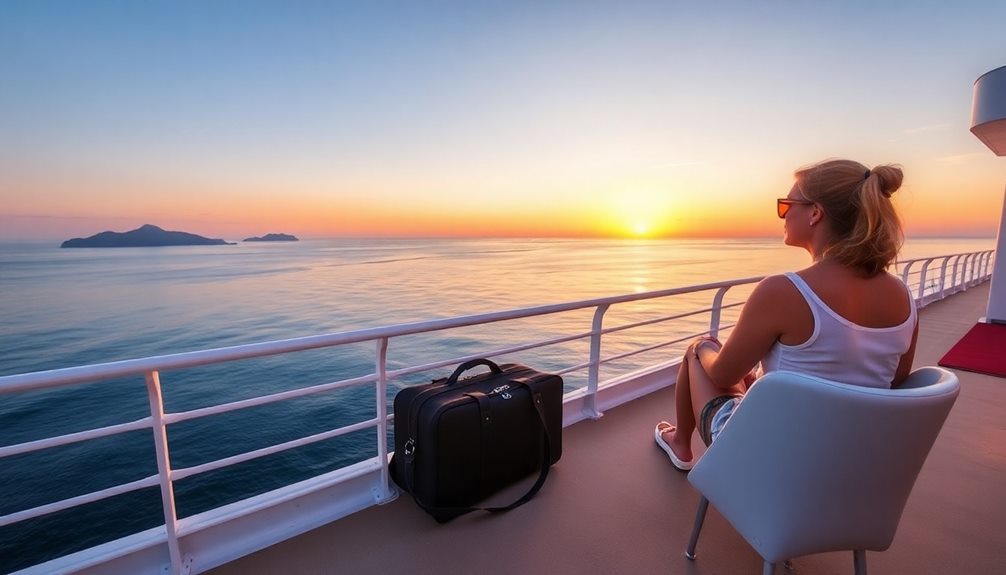
Charting your first cruise can be an exciting adventure, but it's essential to prepare for the experience. To minimize the risk of seasickness, consider booking mid-ship cabins on lower decks. These locations experience less motion, helping you feel more stable throughout your journey.
Additionally, understanding how to handle potential discomfort during travel can be beneficial; for instance, cold medications overview can provide insights into managing symptoms effectively.
Before you board, start taking motion sickness medication like Meclizine or Dramamine the night before. This proactive approach maximizes its effectiveness.
While on the ship, engage in light activities and avoid reading or screen time, as these can trigger nausea.
Staying hydrated is key! Drink water or ginger ale regularly, and opt for small, light meals throughout the day. Heavy meals can worsen discomfort, so keep it simple.
Familiarize yourself with the ship's layout and locate fresh air access points, such as outdoor decks. If you start to feel uneasy, stepping outside and breathing in the fresh air can make a big difference.
Conclusion
As you set sail on your cruise adventure, remember that seasickness doesn't have to ruin your experience. By understanding the causes and symptoms, you can take proactive steps to keep discomfort at bay. Imagine enjoying the ocean breeze, exploring idyllic ports, and savoring delicious meals without worry. With the right strategies in place, you'll navigate the waves with confidence. So, are you ready to commence a journey filled with unforgettable memories? The open sea awaits!
Alfons is the visionary leader and driving force behind Voyager Info’s success. As the Editor in Chief, he brings a wealth of experience and an unwavering passion for travel to the helm of our cruise-centric platform.
With a lifelong fascination for exploring new horizons, Alfons discovered his love for the ocean and cruising at a young age. From sailing across pristine Caribbean waters to embarking on daring expeditions to far-flung destinations, he has amassed a treasure trove of first-hand experiences in the world of cruising.


